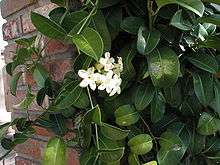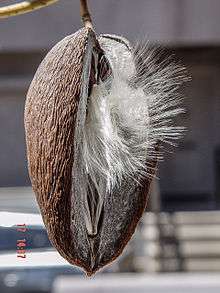Stephanotis floribunda
Stephanotis floribunda syn. S. jasminoides, the Madagascar jasmine, waxflower, Hawaiian wedding flower, or bridal wreath is a species of flowering plant in the family Apocynaceae, native to Madagascar. Growing to 6 m (20 ft) or more, it is an evergreen woody climber with glossy, leathery oval leaves and clusters of pure white, waxy, intensely fragrant tubular flowers.[1]
| Stephanotis floribunda | |
|---|---|
 | |
| Scientific classification | |
| Kingdom: | Plantae |
| Clade: | Tracheophytes |
| Clade: | Angiosperms |
| Clade: | Eudicots |
| Clade: | Asterids |
| Order: | Gentianales |
| Family: | Apocynaceae |
| Genus: | Stephanotis |
| Species: | S. floribunda |
| Binomial name | |
| Stephanotis floribunda | |



Cultivation
Madagascar's climate, with its moderate temperatures, high humidity and seasonal cycles of hot, wet summers and cool, dry winters provides the optimal growing conditions for Stephanotis. Grown commercially, the trumpet-shaped blooms are in season year-round, provided they are given enough light and water, and are a popular component of bridal bouquets. It is a vigorous climber, tough-stemmed, bearing dark green leathery leaves, which grow in pairs at regular intervals along the vine. It grows best in sunny, tropical conditions, or inside. It can flourish for years, grown indoors on a sunny windowsill. Plants can be moved outside or into a greenhouse during the summer.
Few resources are published relating to the culture of this woody vine. In areas where the outside winter temperature drops below 4 °C (39 °F), Stephanotis floribunda can be wintered over in greenhouse or household settings. During the summer growth season, this vine requires full sun, abundant water, high humidity and a balanced fertilizer. The vine will need to be trellised due to the vigorous growth habit. As temperatures begin to cool, pots should be brought indoors and placed in the sunniest location available. If the temperature in the home is on the cool side, the vines slow in their growth and thus should be watered very infrequently. Kept on the cool, sunny and dry side, the plants will "rest" until the outside temperatures begin to rise again, at which time they may be eased back into full sun. They may continue to grow during this period, but it is often slower and less vigorous. When the weather warms, moving the vines into a full sun exposure too quickly will result in leaf blister and sun burns on the plant, rendering it less attractive and damaging the plant's ability to produce food. In ideal conditions, these vines may be kept in bloom all year, but this is difficult in the home setting, especially where Australian possums, to which the leaves are highly attractive, are present.
This plant has gained the Royal Horticultural Society's Award of Garden Merit.[2][3]
Potting
Stephanotis floribunda appears to do best if root bound, thus it is best to not plant the vines in an oversized container. The soil mixture used should have a high content of loam and peat moss with generous drainage material such as perlite or coarse sand. A citrus-type soil mixture works well in most home situations. A soil mixture that retains too much water will lead to root rot.
Watering
Active Growth Stage = When in active growth and in full sun exposure, water until the soil mixture is drenched; the mixture should drain freely. Often the top most roots will become exposed near the stem, but the plant seems not to mind this and it may give the overall appearance more interest. Always allow the potting mixture to dry out before re-watering. As the days begin to cool and shorten, allow longer periods between watering. If kept too wet the leaves will turn yellow and drop, eventually leading to the death of the vine. If too dry, the leaves will lose their gloss and will start to wilt, again ending in death. If noticed in time, a quick watering will often revive the plant.
Although Stephanotis do not technically go dormant, their growth is slowed and flowering is infrequent if kept in a cool, dry condition. When the plants are in a "dormant" or slow growth period, they should be watered just enough to keep the leaves from wilting. They do appear to appreciate daily misting and higher humidity as long as the air flow is good around the plant. During the rest period the plants should not be allowed to stand in water, as they will rot quickly.
Exposure
Stephanotis floribunda requires high levels of light to perform its best and flower. If the light is insufficient for the plant the leaves will begin to turn pale and become chlorotic. The vines do well under artificial light as long as sufficient candle power is provided. If the plant is in a lower light area and there is no available supplementary light source, the room temperature may be lowered and watering withheld in order to induce a more "dormant" state in which to hold the plant over until the plant can be moved back outside.
Temperature ranges
Stephanotis floribunda will withstand temperatures down to 45 degrees F, but will not tolerate frost or freezing of any sort. If the temperature has suddenly dropped and the potted plants are still outside, it is best to move them into a cooler room first to acclimate. The plants can be held over comfortably at 68–80 degrees F as long as there is sufficient light.
In active growth stage they will tolerate temperatures over 100 degrees F, as long as water is sufficient. There are some reports of higher temperatures destroying the strength of the fragrance, one of the reasons this plant is so loved. This vine will do well in temperatures between 70 and 90 degrees F.
Flowers
The flowers are waxy, star-shaped and highly scented, about 3 cm long, in clusters and are produced in summer. This vine flowers only on new growth, and thus pruning should be kept to a minimum, especially during the growth season. Flowers fade to yellow after several days and the deep, rich fragrance turns sour in smell. The blooms are a favourite in weddings, used in bridal bouquets, corsages and decorations. Normally the plant has to be a little old and root bound to start flowering. Once it does, the result is very rewarding. The flowers are long-lasting and sweetly scented.
Fertilizer
During the periods of active growth Stephanotis floribunda do well with a monthly application of a weak mixture of fish emulsion, bone and blood meal. If using salt based fertilizers, "flush" the residue out of the soil every weeks or when the salts start to become noticeable on the surface of the soil or the pot. It is easier to correct under-fertilizing a plant than it is to correct over-fertilizing; usually by the time you notice that you have over-fertilized, it is too late to save the plant. Planted in the ground, the plants enjoy a topcoat of well rotted cow manure in the spring along with the same mixture mentioned above, but using it at a stronger dilution.
Propagation
Propagation is by cuttings or by the seeds, which are produced irregularly. Seeds are produced in a four-inch pod somewhat resembling a mango. Seeds are fully mature in approximately twelve months regardless of whether or not the pod has changed color or split open. Seeds are tightly compacted in the center of the pod and can be removed in one compact bundle, each pod producing 70 to 100 flattened half inch (1.3 cm) seeds. If the seeds are left to dry out, the bundle will begin to break up and silky 'parachutes' will begin to unfurl on each seed in the same manner as the related species, the American milkweed. Seeds propagate best if sown immediately upon opening the pod. Seeds should be sown under only enough soil to keep them moist, and kept in a well lighted place until germination. Fresh seeds will germinate in about seven days. The longer the seeds remain to dry outside the pod before sowing, the longer the germination time and the lower the propagation rate.
In one comparison experiment two pods were taken from the same plant growing outdoors in Houston, Texas, in July 2009. One pod was harvested in June at 11 months of maturity and its seeds dried for one month. The other pod was harvested in July at twelve months. The seeds from both pods were planted at the same time under identical circumstances. The dried seeds took two weeks to germinate at a 60% rate as compared to near 100% germination at one week of the seeds sown within one hour of being removed from the pod. In this experiment the seeds were pushed at various angles into wet seed pots and left under a clear plastic cover in a well-lit, north-facing window at temperatures ranging from 73F to 77F (23C to 25C). The seeds have one pointed end, but the directional orientation of the point in planting did not seem to make a difference in germination.
References
- RHS A-Z encyclopedia of garden plants. United Kingdom: Dorling Kindersley. 2008. p. 1136. ISBN 1405332964.
- "RHS Plant Selector - Stephanotis floribunda". Retrieved 23 February 2020.
- "AGM Plants - Ornamental" (PDF). Royal Horticultural Society. July 2017. p. 99. Retrieved 22 November 2018.